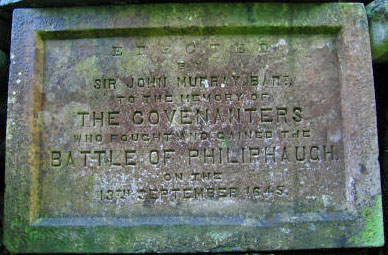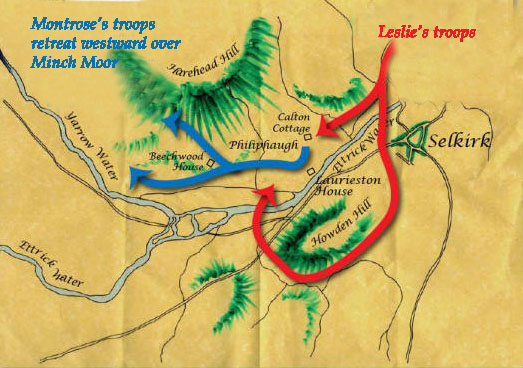The Battle of Philiphaugh
by Norman Turnbull
Turnbull Clan High Shenachie
 The English civil War was really a British Civil War as it obviously embraced Wales, dragged in Ireland and had profound consequences for Scotland. After all Charles I was king of Scotland as well as England and he had his supporters and opponents both North and South of the Border.
The English civil War was really a British Civil War as it obviously embraced Wales, dragged in Ireland and had profound consequences for Scotland. After all Charles I was king of Scotland as well as England and he had his supporters and opponents both North and South of the Border.
A permanent reminder of the Battle of Philiphaugh, this memorial plaque in remembrance of the Convenaters rests on what was once land given to William ‘Rule’ Turnebull by Robert the Bruce.
Philiphaugh was not the usual English v Scots conflict but was a Scottish battle fought on Scottish soil between two sets of Scots; Royalists (supporters of the king) and Covenanters (those who supported the Covenant of 1638 pledged to protect the Presbyterian religion).
In 1643, the Scottish Parliament decided to give military assistance to the English Parliamentarians, on the assumption that a Parliamentary victory would be in the best interests of Scotland.
Although previously a supporter of the Covenanters, James Graham, Marquis of Montrose, remained loyal to the king and became the main champion of the Royalist cause north of the Border. In 1645, after a serious of stunning victories against the Covenanters, Charles I ordered him to march south to the Borders.
On 12th September Montrose arrived at Philiphaugh near Selkirk. Here he camped in a secure position at the junction of the Ettrick and Yarrow rivers, protected by the two rivers to the south and the hills of Ettrick Forest to the North. Meanwhile David Leslie, commander of the Scottish forces fighting in England, marched back into Scotland. By the 12th of September, unknown to Montrose, he was camped nearby between Selkirk and Galashiels. Leslie had around 6,000 men; Montrose only had around 700 as many of his Highland and Irish troops had gone back home and his recruiting efforts in the predominantly Presbyterian Borders had received a lukewarm response.
 Next morning Leslie advanced towards Philiphaugh and split his army into two groups. One group, led by Agnew Lochnaw, moved northwards through the gap between Linglie Hill and Peat Law and attacked Montrose’s troops from the rear. Leslie commanded the second group, which marched along the river valley. Taken by surprise and hopelessly out numbered, Montrose’s men stood little chance. Hastily dug trenches proved inadequate and although Montrose led a sprinted cavalry charge against Leslie’s horsemen and fought bravely, his troops were driven back with great losses.
Next morning Leslie advanced towards Philiphaugh and split his army into two groups. One group, led by Agnew Lochnaw, moved northwards through the gap between Linglie Hill and Peat Law and attacked Montrose’s troops from the rear. Leslie commanded the second group, which marched along the river valley. Taken by surprise and hopelessly out numbered, Montrose’s men stood little chance. Hastily dug trenches proved inadequate and although Montrose led a sprinted cavalry charge against Leslie’s horsemen and fought bravely, his troops were driven back with great losses.
The lucky ones, including Montrose himself, escaped over Minch Moor. The Irish troops that surrendered were either massacred on the battlefield or while in captivity at nearby Newark Castle. For the moment the Royalist cause was over in Scotland as well as in England. This battle was fought on the lands given to the Clan Turnbull by Robert the Bruce for Will-o-Rule saving his life in the Caledonian forest.
From the centre of Selkirk you head down into the valley of the Ettrick Water, walk across the site of the battle and head up into the hills and woods of Philiphaugh Estate on the other side of the valley. The views over the valley and the rolling hills of Ettrick Forest are magnificent, route finding is easy and the climbing is steady rather than strenuous.
